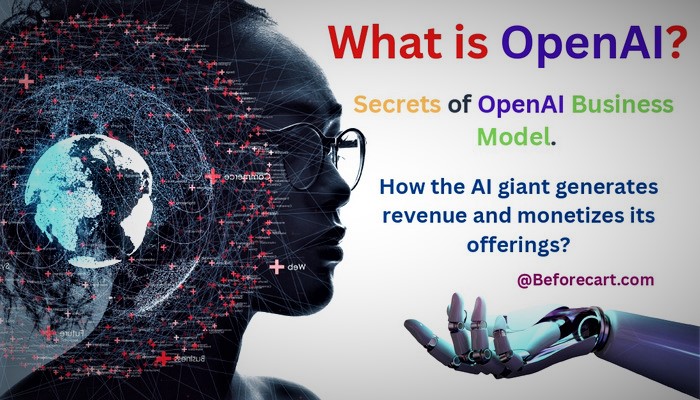Discover the unique OpenAI Business Model, a leading technology company specializing in artificial intelligence research and development. Learn how OpenAI generates revenue through licensing fees for its models and products, investment gains, and partnerships with industry leaders like Microsoft, all under the OpenAI Business Model.
What is OpenAI?
Table of Contents
OpenAI is a research lab specializing in artificial intelligence; it includes a for-profit arm known as OpenAI LP and its non-profit parent company OpenAI Inc. The organization was established in December 2015 by a group of individuals, including Elon Musk, Sam Altman, Greg Brockman, Ilya Sutskever, Wojciech Zaremba, and John Schulman with the goal of progressing and advancing friendly AI for the betterment of humanity. The company’s research focuses on developing and promoting friendly AI through advanced machine learning models such as GPT-3.

OpenAI also offers a platform for training and deploying AI models and a range of tools and resources for researchers and developers in AI. The organization has a strong focus on safety and governance.
You may also read, ChatGPT has accomplished what has been impossible for large companies in the past.
OpenAI’s mission and focus on AI research
OpenAI conducts a wide range of research in the field of AI, including natural language processing, computer vision, and reinforcement learning. The company’s research is intended to help advance the field of AI and make it more accessible to a broader range of people and organizations. Additionally, OpenAI’s research aims to develop AI systems that are safe and reliable, with a focus on avoiding unintended consequences of the technology.
Recommended: Power Players Behind OpenAI
OpenAI’s products and services
OpenAI’s products and services are built on top of its cutting-edge research in AI. They are designed to be easily accessible and usable for many people and organizations. The company’s most well-known products include the GPT-3 language model and the Dall-E image generation model. These products are used in various applications, such as chatbots, language translation, and text summarization.
Overview of GPT and ChatGPT
GPT (Generative Pre-trained Transformer) is a large-scale language model developed by OpenAI. It uses deep learning techniques to generate human-like text based on massive input data. GPT is trained on a diverse range of internet text, including books, articles, and websites, to learn language use patterns and generate text similar to human writing.
GPT-3 is the latest and most advanced version of GPT. It is considered one of the most powerful language models to date, with the ability to generate highly coherent and human-like text across a wide range of topics and styles.
ChatGPT is a variant of GPT-3, specifically fine-tuned for conversational and conversational language understanding. It is designed to generate human-like responses to text inputs and is particularly useful for tasks such as chatbots, language translation, and question answering.
GPT and ChatGPT are based on transformer architecture, allowing them to handle long-range dependencies and understand context, making them powerful models for natural language processing tasks.
Dall-E: OpenAI’s image generation model
Dall-E is an advanced deep-learning model developed by OpenAI that can generate photo-realistic images based on text prompts. It uses natural language processing techniques to understand the meaning of the text and generate an image corresponding to it.
Dall-E is trained on a diverse dataset of images and captions, allowing it to understand and generate a wide range of images and styles. It can generate images from a wide range of concepts and categories, such as animals, objects, landscapes, and even fictional characters and scenes.
Dall-E has a number of potential use cases and applications. One of the most obvious uses is in computer graphics and animation. Dall-E can generate images for video games, movies, and other visual media. Additionally, Dall-E can create images for advertising, product design, and architectural visualization.
Another potential use for Dall-E is in creative writing and storytelling. Dall-E can generate illustrations and covers for books, comics, and other visual media. Dall-E can also be used to generate images for social media, helping to make posts more visually engaging and eye-catching.
Overall, Dall-E is a powerful and versatile image generation model that can be used in many applications. Its ability to understand and generate images based on text prompts makes it a valuable tool for a wide range of industries and disciplines.
Whisper: OpenAI’s audio transcription service
Whisper is an audio transcription service developed by OpenAI. It is a machine-learning model that can transcribe audio recordings of speech to text.
Whisper uses deep learning algorithms to analyze the audio signal and generate a written speech transcript. It is designed to work with a wide range of audio sources, including telephone calls, podcasts, and recorded meetings.
The service is based on the GPT-3 language model and uses the same transformer architecture to process audio and generate transcripts. It allows Whisper to understand the context and handle long-range dependencies in speech, making it highly accurate and efficient at transcribing audio recordings.
Whisper is a cloud-based service that can be accessed through an API, making it easy to integrate into existing applications and workflows. It can be used for many applications, such as creating closed captions for videos, indexing and searching audio recordings, and analyzing speech data for research or business purposes.
How OpenAI generates revenue?
The primary way that OpenAI generates revenue is through licensing fees for its models and products. The organization makes its models and products accessible to the public through an application programming interface (API) or as open-source projects. Customers can then access and use these models and products by paying a licensing fee. OpenAI’s pricing is based on a per-unit basis, with different pricing for different models and products. For example, the Dall-E image generation model is priced on a unit basis of $0.016 to $0.020 per image. According to OpenAI, the pricing of language models is based on tokens, where the usage of 1,000 tokens is equivalent to approximately 750 words.
In addition to licensing fees, OpenAI also generates revenue through investment gains and partnerships. The company has partnerships with various organizations and companies, including Microsoft, which invested $1 billion in 2019. These partnerships provide additional revenue for the company and help ensure it remains financially sustainable. Additionally, OpenAI reorganized itself to become a limited partner (LP), which would cap the profits of its investors at a 100x return. This move simplified access to venture capital and enabled OpenAI to double down on its money-making opportunities.
Licensing fees for OpenAI’s models and products
A vast proportion of OpenAI’s revenue is generated by licensing fees for the usage of its models or products. The company monetizes its offerings on a per-unit basis. Pricing for each product can be accessed on OpenAI’s website.
Investment gains and partnerships for OpenAI
OpenAI has partnerships with various organizations and companies, including Microsoft, which invested $1 billion in the company in 2019. These partnerships provide additional revenue for the company and help ensure it remains financially sustainable.
Microsoft’s partnership and investment in OpenAI
Microsoft’s partnership with OpenAI includes an investment of $1 billion and providing the company with the necessary processing units to train its image and language models. Additionally, Microsoft built a dedicated supercomputer that boasts over 285,000 cores and 10,000 GPUs and could process 400 gigabits per second of network connectivity per server.
Future of OpenAI and AI industry
The future of OpenAI and the AI industry is highly promising, with many potential applications and advancements in the pipeline.
One area of focus for OpenAI is continuing to improve and advance the capabilities of its language models, such as GPT-3, to make them even more powerful and versatile. This could include expanding their ability to understand and generate text and other forms of media, such as images and video.
Another area of focus could be developing specialized AI models for specific industries or tasks, such as healthcare, finance, or transportation. This could lead to the creation of more accurate and efficient AI systems that are better able to assist and augment human decision-making in these fields.
Additionally, OpenAI may continue to focus on the safety and governance of AI, as they have a solid commitment to this area. This could include developing methods for monitoring and controlling the behavior of AI systems, as well as researching the potential impact of AI on society and the economy.
In general, the AI industry is expected to continue overgrowing in the coming years, with increased investment and research leading to new breakthroughs and applications. However, it is also essential to consider AI’s ethical implications and potential risks and work towards developing responsible and beneficial AI systems that augment human capabilities and improve the quality of life.
Recommended: Doordash Business Model
Frequently Asked Questions about OpenAI Business Model:
What is OpenAI?
OpenAI is a technology company that specializes in artificial intelligence (AI) research and development. The company’s mission is to ensure that AI benefits all humanity by conducting research that advances the field and developing products and services that are easily accessible and usable for a diverse group of individuals and companies.
What kind of products and services does OpenAI offer?
OpenAI provides a diverse selection of offerings and services. OpenAI is famous for its GPT-3 language model and Dall-E image generator. These products are considered important and popular among the company’s offerings. These products are used in various applications, such as chatbots, language translation, and text summarization.
How does OpenAI generate revenue?
OpenAI generates revenue primarily through licensing fees for its models and products. The company also makes money via investment gains and partnerships. One such partnership is with Microsoft, which invested $1 billion into the newly-formed OpenAI LP in July 2019.
How much does it cost to use OpenAI’s models and products?
The cost to use OpenAI’s models and products vary depending on the specific model or product. The company’s pricing is based on a per-unit basis, with different pricing for different models and products. For example, the Dall-E image generation model is priced on a unit basis of $0.016 to $0.020 per image.
As per OpenAI, the pricing system for language models is based on tokens, where 1,000 tokens are equivalent to around 750 words.
What is the GPT-3 language model, and what are its capabilities?
GPT-3 is a state-of-the-art AI system capable of understanding and generating natural language. It is one of OpenAI’s most well-known products and is used in various applications such as language translation, text summarization, and chatbots. Other companies can obtain a license for utilizing GPT-3 language model in their products and services.
What is the Dall-E image generation model, and how is it used?
Dall-E is OpenAI’s advanced deep-learning model that can generate photo-realistic images based on text prompts. Dall-E is used in various applications, such as creating images for advertising, video games, and movies.
Is OpenAI’s technology open-source?
OpenAI’s technology is available via an application programming interface (API) or maintained as open-source projects, with the code thus being freely available.
What is the future of OpenAI and the AI industry?
The future of OpenAI and the AI industry is promising, with the company continuing to push the boundaries of what is possible with AI. OpenAI’s research and products are driving advancements in language and image generation. The company’s partnerships with industry leaders such as Microsoft ensure that it remains at the forefront of the industry. As AI technology continues to evolve and improve, OpenAI is well-positioned to continue making significant contributions to the field.
Recommended: Boxycharm Business Model
Conclusion: OpenAI Business Model
OpenAI generates revenue through licensing fees for its models and products, investment gains, and partnerships with industry leaders such as Microsoft. OpenAI Business Model is designed to ensure that it remains financially sustainable while making its products and services accessible to many people and organizations. OpenAI’s innovative approach to monetizing its offerings has helped establish the company as a leader in AI. It will continue to drive its success in the future.
I hope you like this article. If you have any questions, leave a text message in the comment section below.





